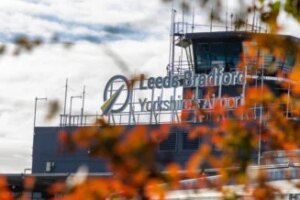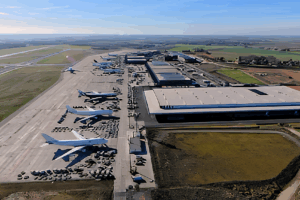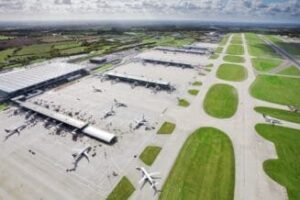
London’s Heathrow Airport today unveiled a £10 billion Private Investment Plan it says is designed to ‘make every journey better’ by improving service levels and boosting its operational reliability.
For the first time in a decade, Heathrow will also create new terminal space for new lounges, shops and restaurants within its existing facilities.
A statement released by the airport notes: “Heathrow is the most punctual major airport in Europe this year and the best-connected airport in the world delivering strong value for our customers and the country. The five-year plan we’re unveiling today is the next plank in our strategy to climb back up the international rankings and be an extraordinary airport, fit for the future.”

Heathrow Airport, Terminal 5A (main terminal building), arrivals concourse, May 2013.
It goes on: “Our plan will deliver on what our customers say matters most to them. It will enable us to better serve our passengers, improve operational resilience and unlock growth for both airlines and UK businesses – with a boost to the UK supply chain in this Parliament.
“It is a 100% privately financed investment in the UK’s hub airport that will make Heathrow more sustainable and prepared for a digital future. It can be delivered affordably with stretching efficiency savings of over £800 million and an airport charge that remains lower than it was a decade ago in real terms.
“Over the past 12 months, we have been working closely with airline partners – including hosting over 120 hours of joint planning – and heard from more than 2 million passengers to understand what matters most, resulting in a customer-led investment plan which will span from 2027 – 2031.
“This major infrastructure programme marks Heathrow’s most significant transformation in over a decade – including creating new space within existing terminals equivalent in size to 10 football pitches. From smoother journeys to new lounges, shops and restaurants, the changes will make Heathrow a more enjoyable, resilient and efficient hub for millions of passengers each year.”

Heathrow, Terminal 5A, landside, passengers in check-in hall, 19th August 2019.
It notes that the aim is for “a delightful journey from check-in to take-off”, a process that involves 99% of bags travelling with passengers; 80% of flights departing on-time; and 95% of passengers waiting less than five minutes at security.
Boosting capacity, trade and Britain’s global reach
Once complete, Heathrow will be able to serve 10 million more passengers a year, a 12% increase in capacity that supports the airlines’ growth plans. Cargo handling will also get a significant lift, with plans to increase freight capacity by 20%, giving UK businesses a more efficient gateway to international markets.
Behind the scenes, the airport is planning the redevelopment of the Central Terminal Area and will seek planning permission to demolish the old Terminal 1, extend Terminal 2 and build a new southern road tunnel to improve access.
Built in Britain, backed by Britain
The project will be delivered by a UK-based supply chain 60% of which is based outside London and the South East, supporting skilled jobs and local businesses around the country in this Parliament. Crucially, it points out, the development programme will be funded entirely through private investment, not taxpayer money, and is designed to be cost-effective.
A £2 billion equity contribution from Heathrow shareholders will mean that the investment plan can be delivered affordably, according to the UK hub.
Heathrow’s airport charge has dropped 23% over the past decade and, even with this investment, the new £33.26 charge remains below 2014 levels in real terms.

A more sustainable Heathrow
The airport is only too aware that it must be seen to be green to ensure its long-term future, so sustainability is a key part of its development plan.
The investment plan, for example, includes steps to reduce the airport’s environmental footprint by removing 3,000,000 tonnes of carbon – equivalent to 15% of 2024 footprint; noise insulation for 6,500 homes and 15 schools; and implementing a sustainable and secure energy supply that maintains 100% renewable electricity.
The airport is also aiming to reduce its waste by 10%, partly by stepping up its recycling efforts, which it wants to increase by 20%.
And Heathrow is keeping its promise to give back – aiming to reach one million people locally with programmes in skills, education and community support by 2030.

Commenting on the investment plan, Heathrow CEO Thomas Woldbye said: “We’re making good progress on our strategy to become an extraordinary airport – having become Europe’s most punctual major airport so far this year. But our customers want us to improve our international rankings further, as do we.
“To compete with global hubs, we must invest. Our five-year plan boosts operational resilience, delivers the better service passengers expect and unlocks the growth capacity airlines want with stretching efficiency targets and a like-for-like lower airport charge than a decade ago.
“With Heathrow’s UK-based supply chain, this private investment will create jobs and drive national growth during this Parliament. We are ready to deliver the more efficient, sustainable Heathrow that will keep Britain connected to the world.”
The CAA will now review and evaluate the plan, this process being supported by the airport and its airline partners.






